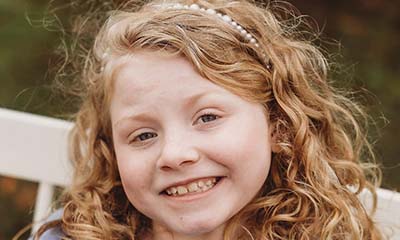Analeigh Albright
September 26, 2023
Categories: Patient Stories
Tags: Bacterial Meningitis, Ischemic Stroke, Intractable Epilepsy
Bacterial Meningitis, Ischemic Stroke, Intractable Epilepsy
Today, it’s commonplace for Jeffrey and Amber Albright to enjoy watching their daughter, Analeigh, participate in some of the same activities as her peers. It’s a sight the Albrights don’t take for granted, as they know what it once took for Analeigh to learn to walk again—twice.
A 2-year-old Analeigh fell ill with what was thought to be a stomach virus, and when Amber checked in on her daughter early one morning, she found Analeigh unresponsive but breathing. After being rushed to a local hospital, Analeigh was brought by ambulance to Children’s of Alabama and admitted to the pediatric intensive care unit (PICU). Initial tests revealed Analeigh had bacterial meningitis, which put her in an epileptic state.
“She was having seizures, and they just wouldn’t stop,” Amber said. “It continued for 48 straight hours.”
Doctors also discovered Analeigh had suffered an ischemic stroke on the left side of her brain. She spent five days on a ventilator as both her family and care team waited to learn the effects of the stroke. When Analeigh woke up, she couldn’t sit up or walk.
“She had a lot of weakness and had lost the ability to use the right side of her body,” her mother explained. “During that time, she was moved from PICU to special care and then the rehab floor, but after about a week of rehab, she was able to walk out of the hospital on her own.”
Analeigh went home with no signs of continued seizures, but after about two weeks, Amber noticed a jerking in Analeigh’s arm. They happened to have a follow-up neurology appointment scheduled, and the neurologist suspected the jerks were seizures. Further testing confirmed Analeigh was having clinical and subclinical seizures. Doctors began trying various medications, but none worked. After three failed medicine attempts, Analeigh’s doctor, Dr. Monisha Goyal, presented her case to the neurology team at Children’s. They recommended a hemispherectomy, a procedure that would disconnect the left and right sides of her brain.
“Her left side was so damaged from the stroke, and that’s where the seizures were happening,” Amber said. “Doctors were afraid that the left side of her brain would eventually teach the right side how to have seizures. That would’ve been extremely dangerous and could have affected her cognitive abilities.”
Though it was a difficult decision for the Albrights, they knew surgery was the best course of action for Analeigh. “We had confidence in Dr. Curtis Rozzelle, her neurosurgeon, and the entire team at Children’s,” Amber said. “We knew they would do exactly what they needed to do in order to preserve Analeigh’s life.”
The six-hour surgery was a success, and Analeigh once again endured rehab—the right side of her brain had to be taught to do things the left side typically did. She also had to learn to walk again, but after two weeks, she walked out of the hospital on her own.
Having made routine clinical visits at Children’s over the years, Analeigh’s condition continues to improve. Due to some ongoing limitations on the right side of her body, she still attends rehab and sees an ophthalmologist at Children’s on a regular basis. At school, she is able to receive her occupational and physical therapies.
As an active fourth-grader, Analeigh enjoys cheerleading and choir. Science is her favorite subject, and she hopes to work in the veterinary field someday.
“She’s doing really well,” Amber said. “We know that the knowledge of the doctors and the rest of the team at Children’s—the therapies they provided, the monitoring of her seizures and their decision to do the surgery—saved her life. Without them, her life could have looked different, and we may not have made the progress that she’s made.”






